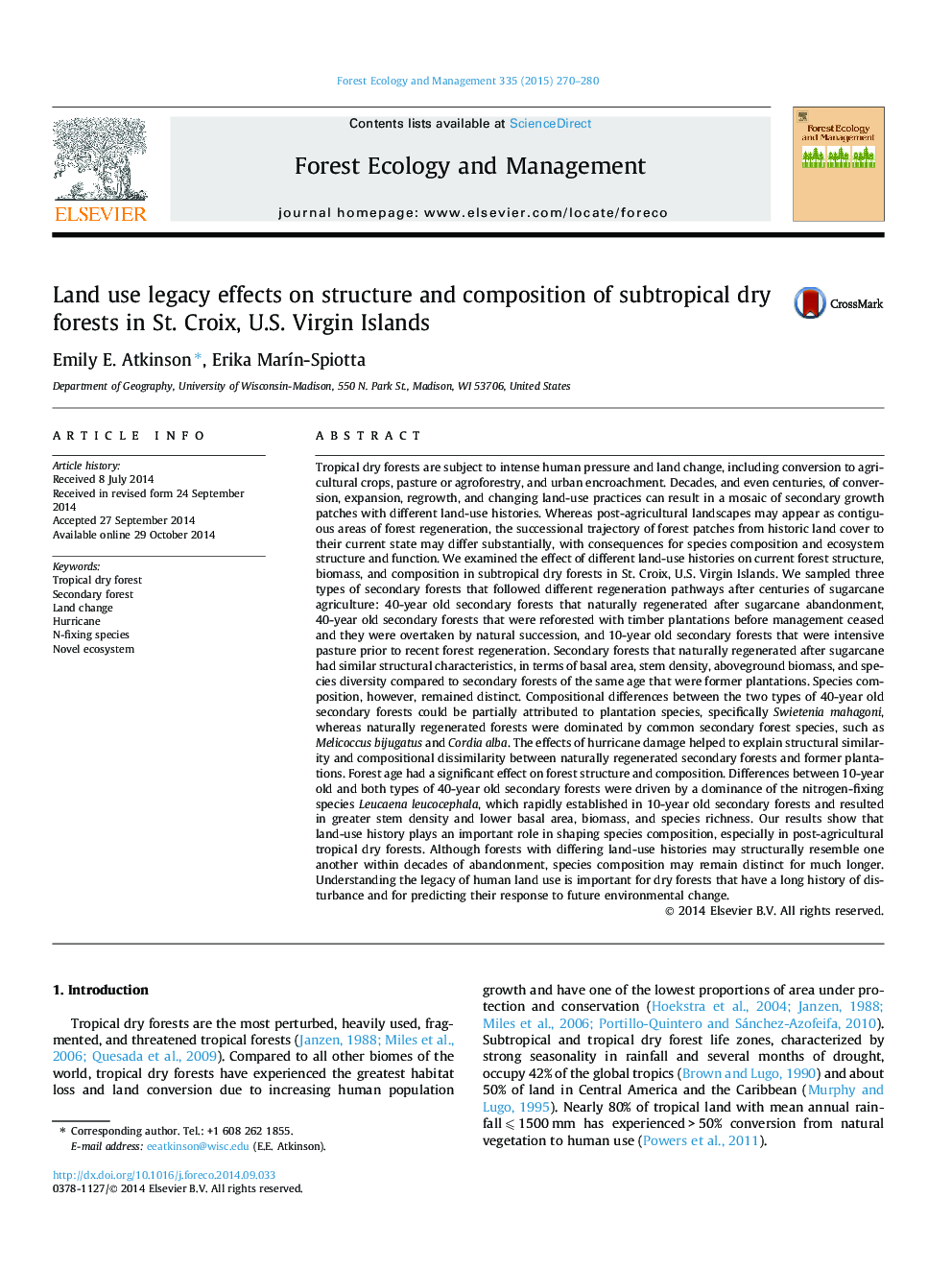| کد مقاله | کد نشریه | سال انتشار | مقاله انگلیسی | نسخه تمام متن |
|---|---|---|---|---|
| 6543055 | 159192 | 2015 | 11 صفحه PDF | دانلود رایگان |
عنوان انگلیسی مقاله ISI
Land use legacy effects on structure and composition of subtropical dry forests in St. Croix, U.S. Virgin Islands
ترجمه فارسی عنوان
اثرات میراث استفاده از زمین بر ساختار و ترکیب جنگل های خشک زیر زمینی در سنت کراچی، جزایر ویرجین ایالات متحده
دانلود مقاله + سفارش ترجمه
دانلود مقاله ISI انگلیسی
رایگان برای ایرانیان
کلمات کلیدی
موضوعات مرتبط
علوم زیستی و بیوفناوری
علوم کشاورزی و بیولوژیک
بوم شناسی، تکامل، رفتار و سامانه شناسی
چکیده انگلیسی
Tropical dry forests are subject to intense human pressure and land change, including conversion to agricultural crops, pasture or agroforestry, and urban encroachment. Decades, and even centuries, of conversion, expansion, regrowth, and changing land-use practices can result in a mosaic of secondary growth patches with different land-use histories. Whereas post-agricultural landscapes may appear as contiguous areas of forest regeneration, the successional trajectory of forest patches from historic land cover to their current state may differ substantially, with consequences for species composition and ecosystem structure and function. We examined the effect of different land-use histories on current forest structure, biomass, and composition in subtropical dry forests in St. Croix, U.S. Virgin Islands. We sampled three types of secondary forests that followed different regeneration pathways after centuries of sugarcane agriculture: 40-year old secondary forests that naturally regenerated after sugarcane abandonment, 40-year old secondary forests that were reforested with timber plantations before management ceased and they were overtaken by natural succession, and 10-year old secondary forests that were intensive pasture prior to recent forest regeneration. Secondary forests that naturally regenerated after sugarcane had similar structural characteristics, in terms of basal area, stem density, aboveground biomass, and species diversity compared to secondary forests of the same age that were former plantations. Species composition, however, remained distinct. Compositional differences between the two types of 40-year old secondary forests could be partially attributed to plantation species, specifically Swietenia mahagoni, whereas naturally regenerated forests were dominated by common secondary forest species, such as Melicoccus bijugatus and Cordia alba. The effects of hurricane damage helped to explain structural similarity and compositional dissimilarity between naturally regenerated secondary forests and former plantations. Forest age had a significant effect on forest structure and composition. Differences between 10-year old and both types of 40-year old secondary forests were driven by a dominance of the nitrogen-fixing species Leucaena leucocephala, which rapidly established in 10-year old secondary forests and resulted in greater stem density and lower basal area, biomass, and species richness. Our results show that land-use history plays an important role in shaping species composition, especially in post-agricultural tropical dry forests. Although forests with differing land-use histories may structurally resemble one another within decades of abandonment, species composition may remain distinct for much longer. Understanding the legacy of human land use is important for dry forests that have a long history of disturbance and for predicting their response to future environmental change.
ناشر
Database: Elsevier - ScienceDirect (ساینس دایرکت)
Journal: Forest Ecology and Management - Volume 335, 1 January 2015, Pages 270-280
Journal: Forest Ecology and Management - Volume 335, 1 January 2015, Pages 270-280
نویسندگان
Emily E. Atkinson, Erika MarÃn-Spiotta,
